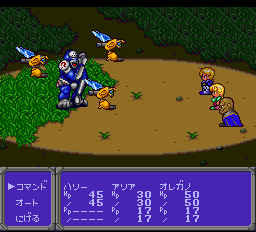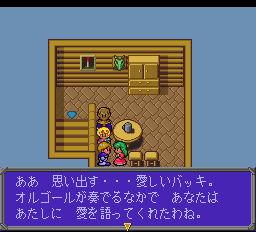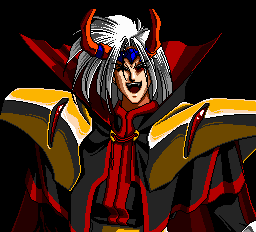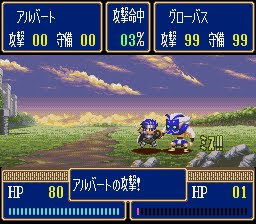Emerald Dragon (エメラルドドラゴン)
Released 1/28/1994, published by NEC
This is a port of a computer game originally released in 1989 for various computers. It was then remade for the FM Towns, a computer designed for multimedia and games. The game was then remade for the PC Engine in 1994, and finally the game was remade again for the Super Famicom in 1995. The SFC version has a translation patch.
The game begins with you controlling the dragon Atorushan on the island of dragons. They haven’t been to the mainland Ishburn for thousands of years because of a curse on dragons there. A girl named Tamlyn washes ashore, and grows up with the dragons.
There is a lot of voiced dialogue, and animated cutscenes (of the usual PCE type). Eventually Tamlyn decides to go back to Ishburn, and Atorushan gives her part of his horn so that she can call for help if necessary. A few years later he decides to go looking for her, and the White Dragon elder at the same time would like him to investigate the curse of Ishburn. Apparently the land is overrun by the Demon Army controlled by the Demon King Garcia. Atorushan gets the Silver Scale which allows him to become human, thus avoiding the curse.
Atorushan looks for Tamlyn, but she has gone to help a magician Bagin try to keep a golem from being reborn. Atorushan goes to find her, but falls into a trap and ends up in a cell with Tamlyn. After a reunion, they head to Bagin, who then releases the golem for them all to defeat.
The battle system is fairly simplistic. You only control Atorushan, The number by the character shows their remaining “action points”, which are used to move and attack. Usually an attack consumes 4 points, but different weapons can use more or less. The other characters move automatically; you can tell them who to attack but that’s it. I would have appreciated a little more control, but the AI is fairly good. The spellcasters seem to have unlimited MP, but there’s no way to even see what spells they have.
One feature that seems to have been added in the SFC version is the dragon ability, where you can use the Emerald Graces (of which the Silver Scale is one) to transform Atorushan into a dragon; this takes most of his HP because of the curse, but does a big attack. If this is in the PCE version, I can’t find a way to use it. The system is simple, but since battles are fairly quick it’s not a huge deal — I certainly prefer this to just mashing “attack” in a typical RPG battle.
Once the golem is taken down, Bagin joins us as we continue to fight the demon army. The next destination is Elbard Castle.
This game, like Ys, has no world map but different screens where the towns run continuously into the wilderness. You can get maps that will show the surrounding areas, as above. It can be somewhat frustrating to find out where to go next. If you press Start you can see your party talk to each other which will usually remind you of where to go next, but it’s not always clear which direction that is, and sometimes you have to remember between several forts or towns.
At Elbard, we clear out a traitorous noble, and then the prince (Hasram) joins the party.
Atorushan and Tamlyn are the only characters who can level up, so the other characters join and leave fairly frequently. Hasram joins us to launch an attack at Zama Fortress, along with Falma. It seems to be controlled be a guy named Ostracon but he’s gone, so we take out his lieutenant Barago instead.
The game is not especially difficult. I think this Barago fight was one of the few that gave me any trouble — as usual for a game of this period, there really isn’t much strategy to use, so it’s just a matter of having the necessary levels and healing items.
As we move on, we hear about a cave that supposedly has dragon spirits.
It does indeed — this is the Silver Dragon, who created the Silver Scale that Atorushan is using. There are five of these “Emerald Graces”. Unfortunately the Emerald Dragon itself is dead, but legend says that if we can unite the five Emerald Graces a miracle will happen and the forces of evil will stand no chance.
Now while all this was going on, Bagin has left the party and charged ahead on his own. He left a letter saying that 20 years ago he tried to get the Purple Gem (one of the Graces) with a friend, who died. To make up for that, he’s going to kill Gomes, a demon terrorizing Nanai Village. So we’ll set out to catch up with him.
Nanai is not an easy place to get to — it requires help of the American Indian knockoffs of this game, the Dardwa people. Along the way we have to go through several other fortresses and towns, including a meeting with Ostracon himself.
Atorushan wounds him so he flees, leaving one of his minions behind to fight. Eventually we reach the Dardwa, but because of their rules, they refuse to let us find the way to Nanai village. However, the son of the elder, Yaman, decides to guide us there. He is thrown out of the village by his father…but I guess we can get to Nanai.
At Nanai, we learn that Gomes is demanding sacrifices from the villagers. To deal with this RPG cliche we head off to fight him — only to find that he’s managed to take out Bagin.
Bagin reveals that he was originally in the demon army, but that a friend helped him escape (who was Falna’s father). He gives us the Purple Gem, and we can pay him back by beating Gomes. He also powers up Falna, who is fairly useless — I think at least now she has more spells, but she tends to just run and attack instead.
Back to the main mission of clearing the demon army out of various strongholds, and finding the other three Emerald Graces. Ostracon is continuing to cause problems, and he sets us to fight his third minion, Bashita.
Now we learn that Hasram (who had returned to Elbard) has been taken captive by Ostracon. He traps him in a black crystal, and then asks for the Avesta (a gem in the Dardwa forest) in exchange. Of course heroes being heroes, we have to go get it from the Dardwa Temple. This requires getting more reluctant cooperation from the Dardwa, and making out way into the temple. A fairy there gives some world background, and then we fight a Dragon Zombie to recover the Avesta.
Of course you know the story — the heroes stupidly trust Ostracon to give us Hasram in exchange for the Avesta. Does he?
Of course not, he just crushes the crystal, killing Hasram. So, it’s time to fight Ostracon. He’s not as hard as we might think, but as usual defeating him just makes him run away, and Hasram’s still dead. Now Garcia will have the Avesta — nice job, heroes.
But, now we can continue on with the main mission. We decide, based on some info, to visit a sage Fushrunum who might have some useful information. Along the way, Yaman gets killed by a random arrow.
Kind of a sudden development, but it’s a way to clear the lower leveled character out to replace him with a new archer named Sayoshant. He’s known as a hero so a nice person to join, but he’s mostly interested in recovering his master’s bow from Ostracon. Fushrunum is living in a hermit hut through a cave, and has some useful information about world backstory, but not much else. He also thinks that Hasram is likely still alive.
Now it’s time to get Ostracon for good. He’s in Durgwand Castle, which the resistance movement has already seized. Making our way through, we finally get to Ostracon. He resurrects his three minions, but since they have the same stats they did when you first fought them, they’re not very hard.
Once he goes down, he asks for extra power from Garcia, and becomes a bigger demon.
I think I was a bit overlevelled because I had trouble finding some of these places, and he went down easily. He has no more tricks up his sleeve, so he (apparently) dies, and we recover the bow, and the crystal with Haslam in it.
This is not a bad game, and the music and visuals are great. I just wish the battle system was a little more involved — I’m in the common position of not being able to say much about the battles because they’re all kind of the same. You can only control Atorushan, and his only options are attack or item. I feel like this is a perfectly playable and decent game on the verge of being a very good game.













































































